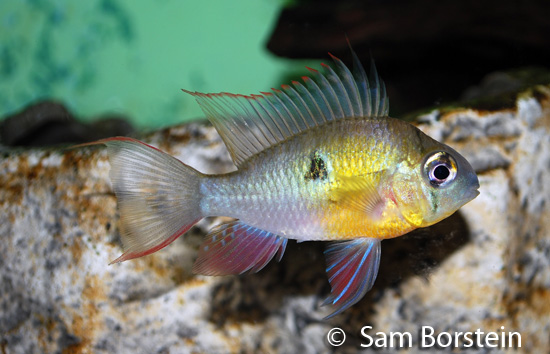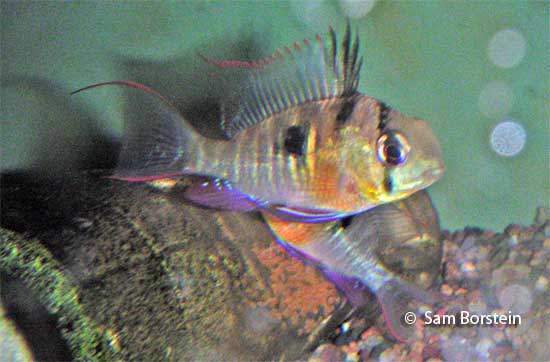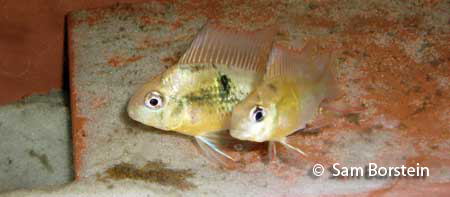Mikrogeophagus altispinosa
(Haseman, 1911)
Bolivian Ram, Ruby Clown Cichlid
Synonyms: Apistogramma altispinosa, Microgeophagus altispinosa, Papilochromis altispinosa

Above: A Mikrogeophagus altispinosa. Photo by Sam Borstein.
Etymology:
Genus- Mikro= small (Greek), geophagus= eartheater (Greek).
Species- alt= tall (Latin), spino= thorn (Latin).
Intro:
Bolivian Rams were first described by Haseman in 1911. For being a popular fish, and being well known in the hobby, it is surprising to know that it was first imported into the hobby in Germany in the mid 1980's and then into the USA.
The Bolivian Ram is related to the German Blue Ram, (Mikrogeophagus ramerizi). This fish is better at parenting and show more behavior than the Blue Rams, and therefore, I believe are more exciting and fun to have.
The genus used to be spelled Microgeophagus, but in the early 2000's, scientists changed the genus spelling to what it is now.
Distribution:
This fish occurs in the Amazaon River basin as well as Bolivia (Hence the common name) in pools found in the scrub.
Size, Maturity, and Sexual Dimorphism:
Size: Males- 3 inches, Females-2.5 inches
Maturity: 1.5 inches
Sexual Dimorphism: Males are larger than females and are more colorful. Females are more yellow in the breast. Males may develop trailers on the fins. Overall, this fish can be hard to sex.
Care:
Bolivian Rams are easy to care for. Because this fish accepts a wide range of water values, it is not hard to keep them happy. This fish is also peaceful, and well mannered. It is fine for a community tank and mixes well with tetras and livebearers. They also can be housed in small species tanks due to their size. I had a breeding pairs in a 10 gallon tank.
Diet:
Bolivian Rams can be picky eaters. I know of some cases where they would only accept frozen or live food. Mine had to be weaned of blood worms and brine shrimp, but eventually started to accept Spectrum pellets. Live food does condition the fish well.
Breeding:
Bolivian Rams are easy to breed. They are a substrate spawner, so give them a flat slate or stone to breed on. These fish condition fast. I got a spawn from my pair every 2 weeks. They are very good parents.

Above: A pair of Bolivian Rams spawning. The eggs are reddish-orange in color. Photo by Sam Borstein.
The fish lay 40-150 eggs, which are reddish-orange. The eggs hatch in about 3 days and the larval egg sac is bright cherry red in color. This is when most people lose their spawn, most likely from the pair eating the larvae. I don't know why they do this, but I believe it has something to do with the larval pigmentation.
Fry are free swimming by 8 days and can be fed baby brine shrimp. They grow pretty fast and are an inch long by 2 months.

Above: A pair of Bolivian Rams over larvae. Photo by Sam Borstein.
Conclusion:
Bolivian Rams are probably my favorite dwarf species. They are colorful, easy to breed, peaceful, and small. This fish is occasionally around pet shops and is usually around hobbyist circles. It's a good fish for people wanting to get into cichlids or wanting to add a cichlid species to their community tank. I highly recommend these guys.
References:
- Haseman, J. D. (1911) An annotated catalog of the cichlid fishes collected by the expedition of the Carnegie Museum to central South America, 1907-10. Annals of the Carnegie Museum, 7, 329-373.
